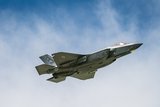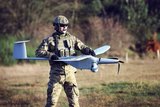Northrop radars for USAF F-16s
Northrop Grumman’s APG-83 Scalable Agile Beam Radar (SABR) has been selected by the US Air Force as the active electronically scanned array (AESA) for its F-16 radar upgrade, the company announced on 7 June.
The company will supply SABR for 72 US Air National Guard F-16s, extending the aircrafts' operational viability and reliability. The upgrade will provide pilots with fifth generation fighter radar capabilities to counter and defeat emerging sophisticated threats.
The APG-83 SABR’s greater bandwidth, speed, and agility allow the F-16 to detect, track and identify targets faster and at longer ranges. The radar can operate in hostile electronic environments and features all-weather, high-resolution synthetic aperture radar mapping, which presents the pilot with a large surface image enabling precision target identification and strike.
The APG-83 AESA fire control radar integrates within the aircraft's current structural, power and cooling constraints without Group A aircraft modification.
Related Equipment in Defence Insight
More from Digital Battlespace
-
![Babcock nears first customer for Nomad AI translation tool]()
Babcock nears first customer for Nomad AI translation tool
Nomad can provide militaries with real-time intelligence, saving critical time on the battlefield.
-
![AUSA 2025: Israel’s Asio Technologies to supply hundreds of improved Taurus tactical systems]()
AUSA 2025: Israel’s Asio Technologies to supply hundreds of improved Taurus tactical systems
Taurus operates alongside the Israel Defense Forces’ Orion system which supports mission management across tens of thousands of manoeuvring forces, from squad leaders to battalion commanders.
-
![AUSA 2025: Kopin pushes micro-LED plans as China moves faster]()
AUSA 2025: Kopin pushes micro-LED plans as China moves faster
The plan for the new displays follows fresh investment in Kopin’s European facilities by Theon and an order for head-up displays in fielded aircraft, with funding from the US Department of Defense.
-
![AUSA 2025: Persistent Systems to complete its largest order by year’s end]()
AUSA 2025: Persistent Systems to complete its largest order by year’s end
Persistent Systems received its largest ever single order for its MPU5 devices and other systems earlier this month and has already delivered the 50 units to the US Army’s 4th Infantry Division.
-
![Aselsan brings in dozens of companies and systems under the Steel Dome umbrella]()
Aselsan brings in dozens of companies and systems under the Steel Dome umbrella
Turkey has joined the family of countries attempting to establish a multilayered air defence system with government approval in August 2024 for the effort landed by Aselsan. Dubbed Steel Dome, the programme joins Israel’s Iron Dome, the US Golden Dome, India’s Mission Sudarshan Chakra and South Korea’s low-altitude missile defence system.
-
![DSEI 2025: MARSS unveils new agnostic multidomain C4 system]()
DSEI 2025: MARSS unveils new agnostic multidomain C4 system
MARSS’ NiDAR system has been deployed using sensors from static platforms to provide detection and protection for static sights, such as critical infrastructure, ports and military bases.




























